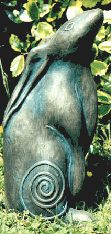 Writes Janet St. John of Arto Paasilinna’s novella, The Year of the Hare:
Writes Janet St. John of Arto Paasilinna’s novella, The Year of the Hare:“A Finnish journalist and a photographer out on assignment one June evening suddenly hit a young hare on a country road. The photographer, ultimately unsympathetic, abandons his journalist companion Vatanen, who sets off to find the wounded hare. Vatanen develops a close bond with the hare and in their adventures together they witness people’s avarice, inhumaneness, hypocrisy, cruelty, participation in bureaucracy, and mere existence, rather than living, in the world. This last realization, in particular, is life altering for Vatanen: he quits his job, discards his hopeless marriage, sacrifices financial security, and sells his most prized possession (a boat). All this Vatanen replaces with a life of odd jobs and on-the-road experiences. This picaresque novel could simply depict a middle-age crisis, but it reaches beyond fantasy or fiction, becoming mythic in its universal themes. The story is inventive, satirical, and quite humorous. It is also refreshingly sentimental in the sense that Paasilinna reaffirms our connection with the animal world and our inherent need for happiness and freedom to maintain quality of life.”

Following is an excerpt from Arto Paasilinna’s The Year of the Hare.
________________________________
 [Vatanen] took the hare in his arms and went out on to the ice, thinking he’d take a walk across the bay, sort his thoughts out and calm down. It was about half a mile to the farther shore.
[Vatanen] took the hare in his arms and went out on to the ice, thinking he’d take a walk across the bay, sort his thoughts out and calm down. It was about half a mile to the farther shore.When he was half-way across, the ravers loosed a couple of large hounds at him. They’d spotted the hare he was carrying. “After ‘em! After ‘em!” they shouted.
The yelping hounds tore across the ice in hot pursuit. The hare took to its heels, and, seeing it on the run, the hounds broke into a fierce baying. Their big paws slithered on the ice as they hurtled past Vatanen and vanished into the trees across the bay.
Vatanen pursued them to the headland, wondering how he could save his hare. What he needed was a gun, but that was hanging on a nail at Läähkimä Gulf.
Several men came running out of the villa, carrying guns. Bellowing as they run, they were like the hounds they’d loosed. The ice bent under their weight.
Vatanen concealed himself among the trees, for as soon as they got to the headland, they fired in his direction. He was lying in the slushy snow, hearing the peevish mumbling of drunken men.
The hare was already far off, the baying of the hounds scarcely audible. Their cry was actually a howl; so the hunt was still on, the hare still alive.
Vatanen’s brain was working overtime. This savage chase must stop, but how? How could such men exist? Where was the pleasure in a rough-house like this? How could human beings lower themselves so viciously?
The poor hare was circling back in terror. Suddenly it burst out of a gap in the trees, saw Vatanen and dashed straight into his arms. Two drops of bright red blood had oozed from its mouth. The baying of the hounds was getting louder.
He knew the hounds could rip the life out of him if he stood there in the forest with a hunted hare in his arms. Should he reject his beloved beast? Send it on its way, save his own skin?
No – the thought shamed him as soon as it came. He ran for a knoll, overgrown with thick-boled, gnarled and twisted pines. Quickly he clambered on one. It was tricky, climbing with a hare in his arms: bits of fur got stuck on the bark; but he was out of reach when the hounds came whirling up, snorting and sniffing the hare’s traces. They soon found their way to the foot of the tree and frenziedly reached up on their hind legs, yelping into the branches, clawing at the red bark with their paws. The hare thrust its head under Vatanen’s armpit, trembling all over.
Boozy voices were again drawing nearer, and soon five men stood at the foot of the tree. . . .






































